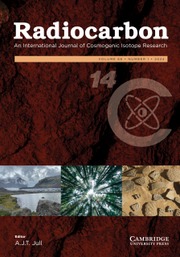Article contents
RETREATMENT OF BONE MATERIAL IN THE GLIWICE RADIOCARBON LABORATORY USING ULTRAFILTRATION
Published online by Cambridge University Press: 19 March 2024
Abstract
Preparation of bones for radiocarbon (14C) dating is still quite a challenge for researchers. The methods are being tested and improved, to increase reliability of dating results and to verify the previous ones. In this work, a set of gelatine samples, extracted from Cervus elaphus and Cervus canadensis bones from various sites in Europe and a set of human bones from archaeological sites in Poland were subjected to retreatment using ultrafiltration in Gliwice Radiocarbon Laboratory. The tested samples represent a wide range of ages, from older than 40,000 14C years BP to modern. The prepared material was subjected to the measurement of C/N atomic ratios and 14C dating using the accelerator mass spectrometry (AMS) technique. Also, the stable isotopes (δ13C and δ15N) values were determined. In a few cases ultrafiltration allows to improve gelatine quality for long-stored samples, by increasing the %C and %N as well as decreasing C/Nat ratios. Nevertheless, this effect was not observed for majority of the samples. Remeasurements of long-term stored samples give mostly the same 14C ages for ultrafiltered ones and for those without ultrafiltration.
Keywords
- Type
- Research Article
- Information
- Copyright
- © The Author(s), 2024. Published by Cambridge University Press on behalf of University of Arizona
References
REFERENCES
- 2
- Cited by



